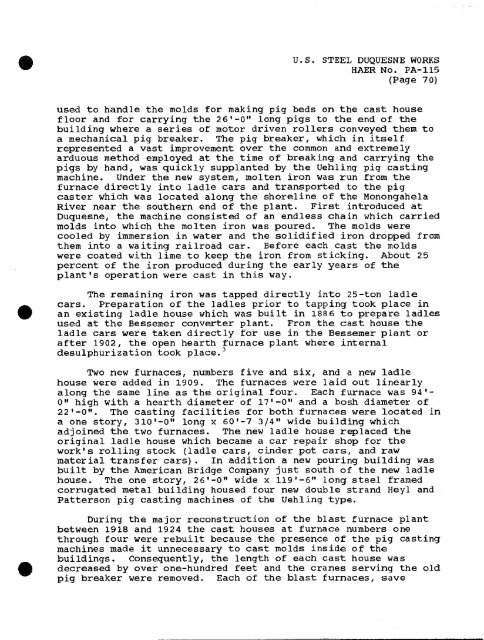pa1778data.pdf
pa1778data.pdf
pa1778data.pdf
Create successful ePaper yourself
Turn your PDF publications into a flip-book with our unique Google optimized e-Paper software.
U.S. STEEL DUQUESNE WORKS<br />
HAER No. PA-115<br />
(Page 70)<br />
used to handle the molds for making pig beds on the cast house<br />
floor and for carrying the 26'-0" long pigs to the end of the<br />
building where a series of motor driven rollers conveyed them to<br />
a mechanical pig breaker. The pig breaker, which in itself<br />
represented a vast improvement over the common and extremely<br />
arduous method employed at the time of breaking and carrying the<br />
pigs by hand, was quickly supplanted by the Uehling pig casting<br />
machine. Under the new system, molten iron was run from the<br />
furnace directly into ladle cars and transported to the pig<br />
caster which was located along the shoreline of the Monongahela<br />
River near the southern end of the plant. First introduced at<br />
Duquesne, the machine consisted of an endless chain which carried<br />
molds into which the molten iron was poured. The molds were<br />
cooled by immersion in water and the solidified iron dropped from<br />
them into a waiting railroad car. Before each cast the molds<br />
were coated with lime to keep the iron from sticking. About 25<br />
percent of the iron produced during the early years of the<br />
plant's operation were cast in this way.<br />
The remaining iron was tapped directly into 25-ton ladle<br />
cars. Preparation of the ladles prior to tapping took place in<br />
an existing ladle house which was built in 188 6 to prepare ladles<br />
used at the Bessemer converter plant. From the cast house the<br />
ladle cars were taken directly for use in the Bessemer plant or<br />
after 1902, the open hearth furnace plant where internal<br />
desulphurization took place. 3<br />
Two new furnaces, numbers five and six, and a new ladle<br />
house were added in 1909. The furnaces were laid out linearly<br />
along the same line as the original four. Each furnace was 94 1 -<br />
0" high with a hearth diameter of 17'-0" and a bosh diameter of<br />
22"-0". The casting facilities for both furnaces were located in<br />
a one story, 310'-0" long x 60'-7 3/4" wide building which<br />
adjoined the two furnaces. The new ladle house replaced the<br />
original ladle house which became a car repair shop for the<br />
work's rolling stock (ladle cars, cinder pot cars, and raw<br />
material transfer cars). In addition a new pouring building was<br />
built by the American Bridge Company just south of the new ladle<br />
house. The one story, 26*-0" wide x 119'-6" long steel framed<br />
corrugated metal building housed four new double strand Heyl and<br />
Patterson pig casting machines of the Uehling type.<br />
During the major reconstruction of the blast furnace plant<br />
between 1918 and 1924 the cast houses at furnace numbers one<br />
through four were rebuilt because the presence of the pig casting<br />
machines made it unnecessary to cast molds inside of the<br />
buildings. Consequently, the length of each cast house was<br />
decreased by over one-hundred feet and the cranes serving the old<br />
pig breaker were removed. Each of the blast furnaces, save

















